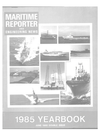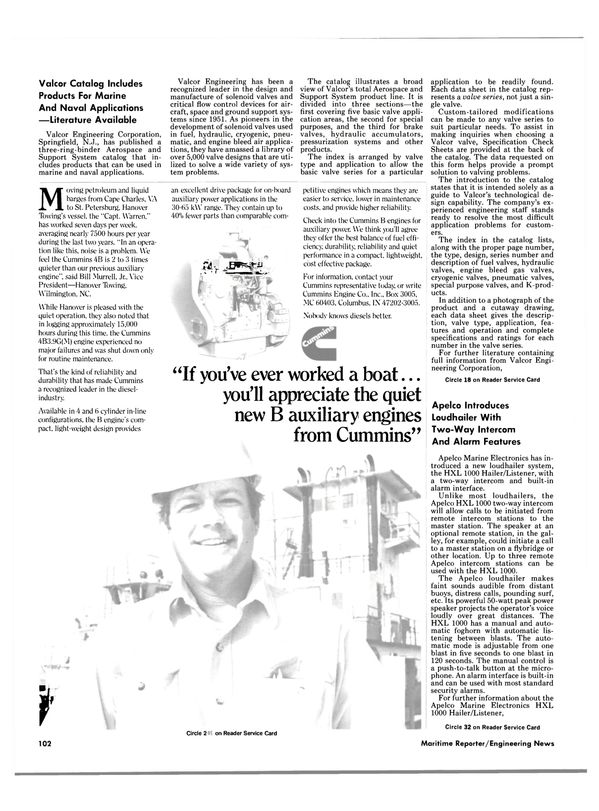
Southwest Marine Yard Repowering San Francisco Commuter Ferries With Detroit Diesel Allison Engines
New diesel engines in three of San Francisco's commuter ferries are expected to save their owner, the Golden Gate Bridge, Highway and Transportation District, more than a quarter-million dollars a year in fuel costs. A pair of fuel-efficient Detroit Diesel Allison 16V-149TIB engines are replacing the three gas turbines that were installed in each of the 725-passenger vessels when they were built in the mid-1970s.
The repowering is being done by Southwest Marine, Inc. of San Diego.
The San Francisco, first of the three ferries to be repowered, has been in service for several months.
Even during her break-in period, Ferry Division manager Eric Robinson has found "dramatically improved performance" from the repowered boat, leading to a savings in commute time as well as impressive dollar savings. These savings are being achieved despite a reduction of propulsion power from 7,500 shp with the original gas turbines to 3,100 bhp with the new diesels. Reliability has been 100 percent, and the noise level has been as low as it was with the gas turbines.
The economies gained from the repowering program will show up in expanded service of the ferries, which were built to relieve commuter congestion on the Golden Gate Bridge. When all three boats are back in service, Mr. Robinson expects ridership to increase by 40 percent over previous levels, further adding to the economic viability of the Ferry Division. He also notes a 60-percent reduction in fuel consumption during the first threemonth operation of the San Francisco.
The three ferries—San Francisco, Marin, and Sonoma—provide passenger- only commuter service between the Ferry Building terminal close to downtown San Francisco and the port of Larkspur serving the residential communities of Marin County. Passengers travel in luxury during the 45-minute crossing, with beverage service and intercom music throughout the enclosed, multideck boats.
Fuel savings have already met the goals set for the repowering, and overall performance has exceeded expectations. Hourly full-power fuel consumption has averaged 170 gallons with the two diesels and one genset; the original gas turbines burned 500 gallons an hour. Cruising speed has met the boat's design speed of 20.2 knots—surprising in view of the great reduction in horsepower.
A critical demand has been that ferry service be increased to meet anticipated ridership, and that the Division's high level of on-time ferry departures and landings be maintained.
The markedly improved performance of the boat at slow and intermediate speeds, the result of conversion from waterjet to propeller propulsion, is already paying off in terms of time saved during docking and departures, and has added an important margin of safety to ferry operation.
In order to convert from the waterjets to propellers, a five-foot "bustle" is added to the stern of each ferry to house rudders and steering mechanism. This slight increase in the waterline length of the 165-foot boats has contributed to maintaining the original design speed.
Repowering of the second and third boats is continuing, with the Marin and Sonoma expected to be in service by the end of this year.
For further information and free literature on Detroit Diesel engines, Circle 9 5 on Reader Service Card
Read Southwest Marine Yard Repowering San Francisco Commuter Ferries With Detroit Diesel Allison Engines in Pdf, Flash or Html5 edition of June 1985 Maritime Reporter
Other stories from June 1985 issue
Content
- McDermott Gets Contract From SOHIO To Build Offshore Drilling Platform page: 6
- Shipboard Safety Criteria Monitored By Siemens Computer page: 6
- Puroflow Gets Canadian Order For Ultraviolet Water Purification Systems page: 6
- Moss Point Marine To Build Victorian-Style Sternwheel Riverboat page: 7
- Fiberglass Passenger Vessel Built By Westport For Catalina Channel page: 8
- New Facility Opened By Lips Propellers At Todd-Seattle Shipyard page: 9
- Samson Offers Brochure On Passive Mooring Systems For Supply Vessels page: 9
- Marathon LeTourneau To Construct World's Largest Bottom Supported Mobile Offshore Drilling Unit page: 12
- GEC Rolls-Royce Gensets Selected For Shell/Esso Tern Offshore Platform page: 14
- A S S C O Elects B a u m l e r V P - M a r k e t i ng page: 15
- N e w B r o c h u r e F r om W e s t i n g h o u s e Discusses C o m b u s t i o n T r i m C o n t r ol page: 15
- Raytheon Introduces JRC Color And Digital Rasterscan Radar Unit page: 16
- Simpson Timber Restructuring Its Panel Products Division page: 16
- Ingersoll-Rand Signs Sales Agreement With Kawasaki page: 17
- Murray Grainger Resumes Business Activities As Used Equipment Dealer page: 20
- New Remote Control VHF Marine Radio Introduced By Uniden page: 20
- Mitsubishi Introduces Latest Diesel Engine At New York Seminar page: 21
- Contract For Wharf At Cow Head Oil Rig Servicing Facility Awarded page: 22
- Marathon LeTourneau Exhibits Slo-Rol® Motion Suppression Technology During 1985 OTC page: 23
- Aluminum Boats Delivers Whale Watch Excursion Boat page: 23
- I.T.C. Holland Engineers Its Third Double Rig Dry Transport On The Sibig Venture page: 25
- Hitachi Zosen Completes Two Power Generating Barges For Philippines page: 25
- FUTURE U.S. NAVY BUSINESS OPPORTUNITIES —A $230 billion # 5 Year Market— page: 26
- US SHIPBUILDING OUTLOOK Markets & Cost Saving page: 44
- Secretary Dole Promulgates CDS Repayment Rule page: 44
- U.S. MARITIME ASSETS AND NATIONAL SECURITY page: 48
- THE CIRCLE OF RELIANCE " I n Time of War, Land, Sea, and Air Forces and All Logistic Support Functions Must Work as a Team" page: 50
- THE GOVERNMENT AS PARENT TO INDUSTRY: PARTICIPATION OR BENIGN NEGLECT? page: 52
- A SUCCESSFUL MARITIME POLICY UNDER ATTACK page: 58
- Offshore Service Vessels, Tugboat And Inland Towboat Fleets page: 60
- U.S. COULD LEARN A LESSON FROM GREAT BRITAIN'S OFFSHORE OIL LEASING page: 65
- CANADIAN SHIPBUILDING — 1985 — page: 76
- Liu Elected Vice President Of American Bureau To Head R&D Division page: 79
- VTHE NEW DDG-51 CLASS GUIDED MISSILE DESTROYERS —A Report— page: 80
- Harris Gets Subcontract To Supply HF Equipment For Canadian Frigate Program page: 89
- Brochure On "Sea Float" Marine Buoys And Floats Offered By Seaward page: 89
- Multi-Purpose Freighters To Be Built By Seebeck page: 89
- Omnipure Awarded $1.3-Million Contract From Canadian Navy page: 90
- New IMA Report On Future U.S. Navy Procurement Now Available page: 90
- Dubai Drydocks Reports Profit For Second Year page: 91
- Farboil Offers Free Four-Color Folder On Wetsall® Coatings page: 91
- Devoe Offers Brochure On Marine And Corrosion Control Paints & Coatings page: 92
- New Portable Hoists Line With Failsafe Brakes Now Available From PHD page: 92
- World Transport Coordinates Wet Tow Of Western Oceanic Rig page: 93
- Marinette Marine Installs First DWB Ship Transfer System In North America page: 93
- Norcontrol Offers Brochures On Navigation/Instrumentation Line Marketed In U.S. By Nav-Control page: 94
- Nichols Brothers Builds New McNeil Island Ferry page: 97
- Rowan Offers Free Literature On Drill Rig 'Rowan Gorilla IV' page: 97
- Raytheon Introduces Newest SatCom For Fishing And Pleasure Craft page: 98
- Crawford Fitting Introduces Gap Inspection Gages For SWAGELOK Tube Fittings page: 98
- Jeffboat Delivers Deck Barge For Nugent Sand Company page: 99
- Unique Actuator Selection Slide Chart Available From Jamesbury Corp. page: 99
- CRUISE '85 SHIPS • OPERATIONS • SERVICES page: 100
- Aeroquip T-J Division Offers New Series TP Proximity Switches page: 101
- Valcor Catalog Includes Products For Marine And Naval Applications page: 102
- Apelco Introduces Loudhailer With Two-Way Intercom And Alarm Features page: 102
- Marine Management Develops Demo Programs page: 103
- Marco-Seattle Converts Two Combination Crabbers For New Fishery Roles page: 103
- Markey Supplies Tug With Two Capstans page: 104
- Southwest Marine Yard Repowering San Francisco Commuter Ferries With Detroit Diesel Allison Engines page: 104
- AMETEK Announces Computerized Inspection Management System page: 105
- "Marine Library" Literature Available From DDA page: 105
- Furuno Introduces FR-803D Digital Radar page: 105
- MariChem 85 page: 106
- LIQUID CARGO HANDLING EQUIPMENT —A Review— page: 108
- Marathon LeTourneau GranGulf™ Semi Design Offers Economic Construction & Optimum Deck Load page: 113
- First Interactive Shiphandling Simulators From Ship Analytics Being Commissioned page: 116
- Stewart & Stevenson 'Mean 16' Provides Patrol Boats With New Power And Cruising Range page: 119
- Literature Available On Navlink From Datamarine page: 119
- Elliott White Gill Names New Sales Agent For Taiwan page: 120
- Blackinton Named General Manager Of Bethlehem-Beaumont Yard page: 120
- DAMPA Continuous Ceiling Approved By U.S. Navy— page: 121
- Ingersoll-Rand Forms New Compressors Division page: 122
- Menge Named Agent For Seaward Fenders page: 122
- Lanzendorfer Will Manage Fairbanks Morse Service Facility in San Diego page: 124
- $5.3-Million Navy Program Received By Tracor page: 124
- Gensler Named Director Of Marketing And Sales For InterTrade Industries page: 124
- WABCO Offers 8-page Brochure On Logicmaster™ Marine Propulsion Control Systems page: 133
- Free 12-Page Color Brochure Availale From Falk On New Shaft Speed Reducer Line page: 133


